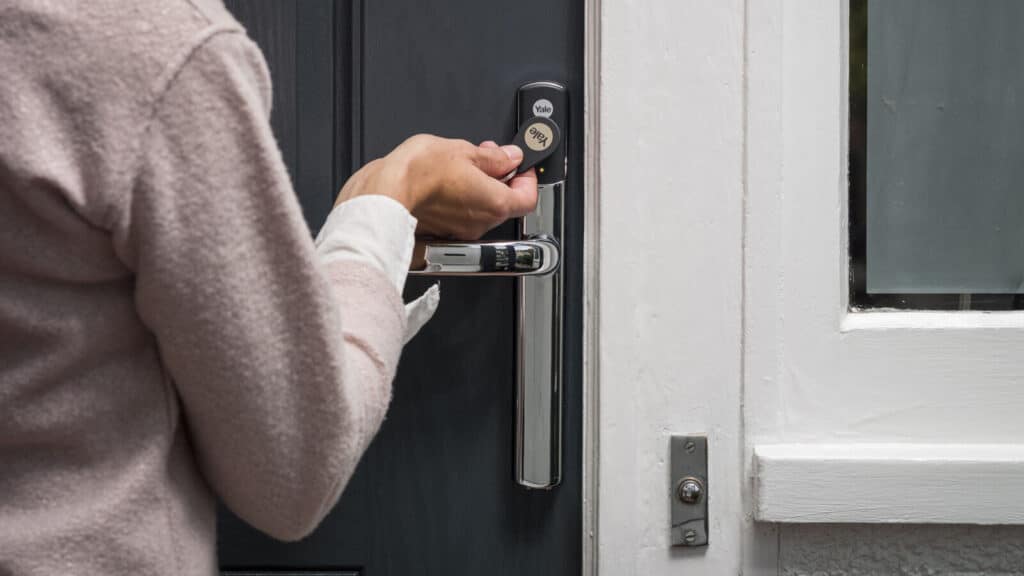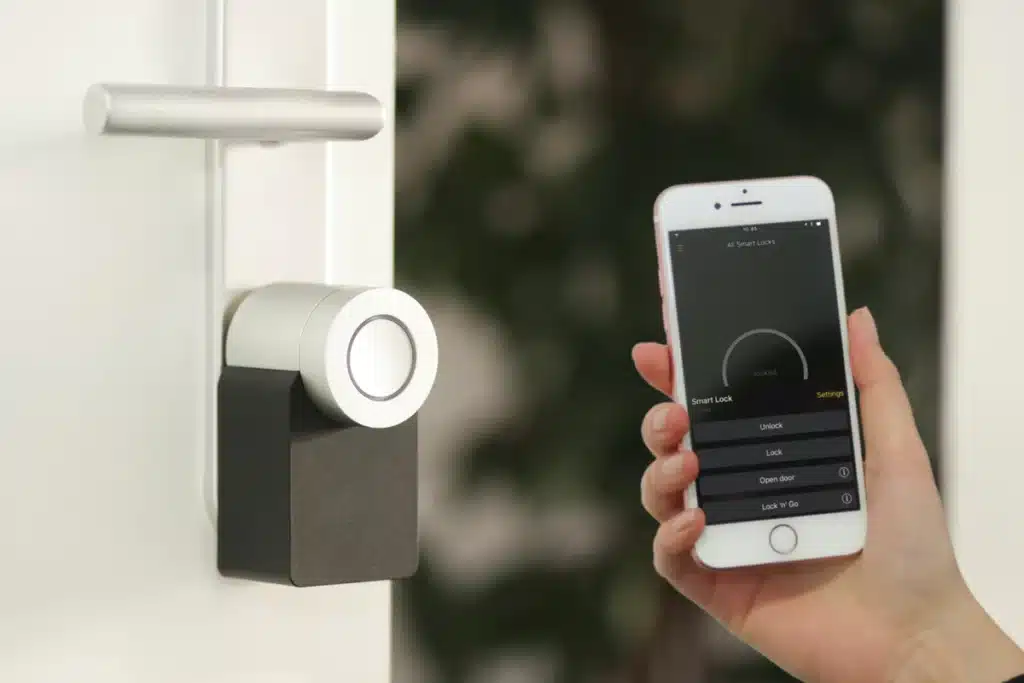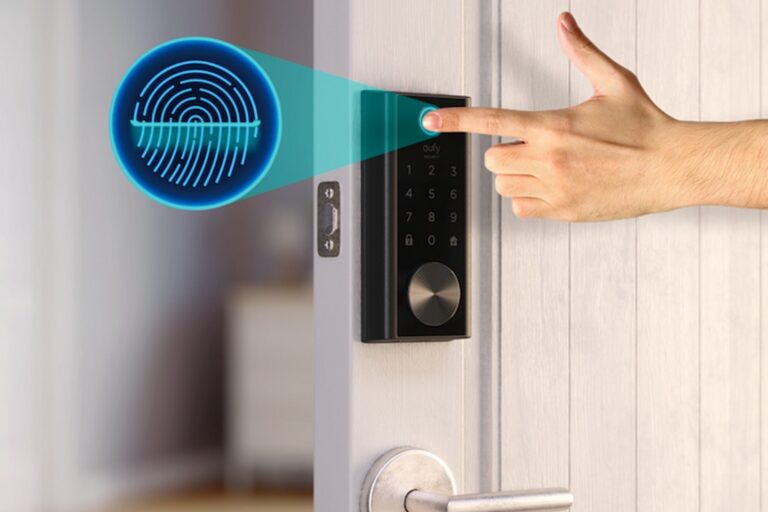Introduction
How To Open Smart Door Lock: Smart door locks have become increasingly popular in recent years, offering convenience, security, and enhanced control over access to your home or office. Unlike traditional locks, smart door locks utilize advanced technology to allow keyless entry and remote access management. Whether you’re a tech enthusiast or simply looking to upgrade your home security system, learning how to open a smart door lock is essential.
The step-by-step process of opening a smart door lock, highlighting the common methods and considerations involved. The specific instructions may vary depending on the brand and model of your smart lock. The primary methods of accessing a smart door lock, which typically include keypad entry, mobile app control, and key fobs. The necessary setup steps for each method, highlighting the installation and registration processes required.
Additionally, explore troubleshooting techniques for common issues that may arise with smart door locks, such as battery replacement, connectivity problems, and lockout situations. Understanding how to troubleshoot these problems will help ensure a seamless and secure experience with your smart door lock.

Can smart locks be opened remotely?
You can remotely manage access with a smart door lock
Unlike Bluetooth, Wi-Fi or 4G smart door locks can be operated remotely. This helps when guests or contractors require a property but haven’t been given a digital key.
Smart locks may be unlocked remotely like other internet-connected devices. Smart locks improve security and convenience, but their internet connection might expose them to hackers.
The ability to open a smart lock remotely largely depends on the specific model and its associated software. Some smart locks offer remote unlocking capabilities as a feature, allowing authorized users to lock and unlock their doors using a smartphone app or a web portal. These locks typically rely on secure communication protocols and encryption to ensure the remote commands are transmitted securely.
However, remote access may be vulnerable. Hackers may remotely open smart locks using insecure software or firmware. Some smart locks have security weaknesses or insufficient encryption mechanisms, making them hackable.
Some models employ advanced security measures, such as two-factor authentication or biometric authentication, to prevent unauthorized access. Users should thoroughly research and choose a reputable smart lock manufacturer that prioritizes security and regularly updates their software to address any vulnerabilities that may arise.
How do you open a smart door lock?
Smart locks using Bluetooth
Smart lock apps for native smart door locks work in a similar way, all controlled by the manufacturer of the smart lock. Invariably, digital keys will be shared with you. To unlock a particular door, it will simply be a case of selecting the key and using it to unlock the door.
Opening a smart door lock depends on the specific model and its features. However, here are some common methods used to open a smart door lock:
Smartphone App: Many smart door locks come with a dedicated smartphone app. After installing the app and connecting it to the lock, you can typically open the lock by simply tapping a button within the app. This method often requires the smartphone to be within Bluetooth or Wi-Fi range of the lock.
Keypad Entry: Some smart locks have built-in keypads that allow you to enter a PIN code to unlock the door. This method can be handy if you don’t have your smartphone or if you want to provide access to someone without a smartphone. Some smart locks may be coupled with portable key fobs or keycards. Showing the lock the key fob or keycard unlocks the door.
Voice Control: Amazon Alexa and Google Assistant can interface with certain smart locks. By using voice commands, you can instruct the virtual assistant to unlock the door for you.
Remote Unlocking: Depending on the model and features, some smart locks offer remote unlocking capabilities. This means you can open the lock from anywhere using a smartphone app or a web portal. It usually requires an internet connection and secure authentication.
How do I remove a Smart Lock password?
To disable Google Smart Lock, open Google Chrome on your device and go to settings. Tap on Passwords and turn off Save Passwords and Auto sign-in.
To remove a password from a smart lock, the specific steps may vary depending on the model and brand of the lock. However, here are some general guidelines to follow:
Consult the User Manual: The first step is to refer to the user manual or instructions provided by the manufacturer. The manual should contain specific information on how to remove or reset the password for your particular smart lock model.
Factory Reset: Many smart locks have a factory reset option that allows you to restore the lock to its default settings. This process will typically remove any existing passwords and configurations. Check the user manual for instructions on how to perform a factory reset for your smart lock.
Physical Reset Button: Some smart locks have a physical reset button that you can press to initiate a reset. This button is usually located on the lock itself or behind a small panel. Again, consult the user manual to locate the reset button and follow the provided instructions.
Mobile App or Web Portal: If you have been using a mobile app or web portal to manage your smart lock, there may be an option within the app or portal to remove or reset the password. Open the app or access the portal, navigate to the lock settings, and look for options related to password management.
How does the smart door lock work?
Like all locks, smart locks operate with the use of a lock and a key. But in this case, the key is digital rather than physical. The key might be a keypad code or a cryptography-enabled smartphone app command.
Smart door locks combine classic lock mechanisms with current technologies for ease and security. A brief explanation of smart door locks:
Smart and standard door locks install similarly. They may be put in conventional entrances per manufacturer’s directions.
Smart door locks include Bluetooth, Wi-Fi, or Zigbee. This connection lets the lock talk to smartphones, smart hubs, and voice assistants.
Smart door locks employ many techniques to verify the user’s identification before providing entry. This may involve inputting a keypad PIN, utilizing a smartphone app with biometric identification (such fingerprint or face recognition), or presenting a key fob or keycard.
After identification verification, the smart door lock may be remotely or locally locked and opened. Smartphone apps let users operate the lock from anywhere with an internet connection. Smart locks with voice assistants may also lock and open the door. Many smart door locks include activity tracking and alerts. They record when the door is locked or opened, letting users monitor property access. Sometimes locks transmit real-time alerts to the user’s smartphone when the lock state changes.
Smart door locks can be linked into smart home ecosystems. Integration lets users automate lock operations based on triggers or schedules and manage the lock with other connected devices like security cameras and lighting.

Do smart locks have keys?
Smart Locks Can Have Keys – But Don’t Require Them
A smart lock requires a key, although it may not be physical. Smart locks link to your home’s WiFi or Bluetooth.
Smart locks rely on wireless communication and digital verification, while conventional keys bring convenience and security. Keys in smart locks:
Smart locks with keys enable users to manually lock and open the door using mechanical keys. This is handy when the smart lock’s digital functions are unavailable or malfunctioning or when allowing entry to those without cellphones or digital credentials. Power outages, technological malfunctions, and dead batteries might make a physical key essential. The key is a backup for property access in such instances.
User Preference: Some individuals prefer the comfort and security of a physical key. Even with a smart lock, a key may give confidence and security, especially for longtime users of conventional locks.
Keyless Options: Not all smart locks have keys. Keyless entry versions may not have a key. These locks only accept digital authentication like PIN numbers, biometric data, or smartphone applications.
Key Management: Smart locks with physical keys must be managed and secured. Protect the keys as you would conventional locks by keeping them securely.
What is a smart door lock?
Sophisticated smart door locks provide convenience, control, and security for home and business doors. It combines traditional lock mechanisms with digital connectivity and authentication methods. Here’s a brief overview of what a smart door lock is:
Connectivity: Smart door locks are equipped with wireless connectivity options such as Bluetooth, Wi-Fi, or Zigbee. This connectivity allows the lock to communicate with other devices like smartphones, smart hubs, or voice assistants.
Authentication Methods: Smart door locks offer various authentication methods to verify the user’s identity before granting access. These can include PIN codes entered on a keypad, biometric authentication (fingerprint or facial recognition), smartphone apps, or key fobs/keycards.
Remote Access: One of the key features of smart door locks is the ability to control and monitor the lock remotely. Users can use a smartphone app or a web portal to lock or unlock the door from anywhere with an internet connection. This enables convenient access management and monitoring.
Keyless Entry: Smart door locks often eliminate the need for physical keys altogether, relying solely on digital authentication methods. This provides keyless entry, eliminating concerns like lost or stolen keys and allowing for easy sharing of access with family members, guests, or service providers.
Smart home ecosystems may include smart door locks. Smart gadgets like security cameras, doorbells, and lighting can communicate. This connection lets customers automate activities and improve home security and comfort.
Can I still use a traditional key with a smart door lock?
Yes, in many cases, you can still use a traditional key with a smart door lock. The inclusion of a physical key option is a common feature in smart door locks, providing users with a backup method of entry or allowing for compatibility with existing key-based systems. Here are some key points to consider:
Keyed Access: Smart door locks that support traditional keys have a keyway or keyhole on the lock mechanism, similar to traditional locks. This allows users to use a physical key to lock and unlock the door manually, providing a familiar and reliable method of entry.
Convenience and Flexibility: Having the option to use a traditional key can be beneficial in various situations. For example, if the smart lock’s digital features are inaccessible due to technical issues or power outages, you can still rely on the physical key to enter the property. Additionally, providing access to individuals who may not have smartphones or digital credentials becomes possible with a traditional key.
Compatibility: Including a key option in smart door locks ensures compatibility with existing key-based systems. If you have multiple entry points or locks in your property, having traditional keys allows you to maintain consistent access across all doors.
Key Management: If your smart door lock supports traditional keys, it’s essential to manage them properly. Treat the keys with the same level of security as you would for traditional locks. Consider storing them securely to prevent unauthorized access.
Are smart door locks secure?
Smart door locks can provide enhanced security compared to traditional locks, but their overall security depends on several factors, including the specific model, manufacturer, and user practices. Here are some considerations regarding the security of smart door locks:
Encryption and Authentication: Secure smart door locks use encryption protocols to protect communication between the lock and connected devices. They also employ strong authentication methods, such as PIN codes, biometric data, or secure smartphone apps, to ensure only authorized individuals can access the lock.
Like other internet-connected devices: smart door locks may have flaws that hackers might exploit. However, reputable manufacturers actively monitor and address security vulnerabilities through regular software updates. It is crucial for users to keep their smart locks’ firmware up to date to benefit from these security patches.
Physical Security: While smart door locks add digital features, they still rely on the physical security of the door itself. A strong door and frame, along with quality installation, are essential to maximize overall security.
Password and Access Management: Users play a critical role in maintaining the security of their smart locks. It is essential to use strong, unique passwords, enable two-factor authentication when available, and regularly review and manage access permissions. Properly managing and securing physical keys, if applicable, is also crucial.
Manufacturer Reputation: Choosing a smart lock from a reputable manufacturer is important. Look for brands that prioritize security, provide regular firmware updates, and have a track record of addressing vulnerabilities promptly.

Conclusion
Opening a smart door lock is a straightforward process that offers convenience, enhanced security, and remote access control. Through the various methods discussed in this guide, including keypad entry, mobile app control, and key fobs, users can enjoy keyless entry and manage access to their homes or offices with ease.
By following the step-by-step instructions provided by the manufacturer and considering the specific setup requirements for your smart door lock, you can successfully open your lock and take full advantage of its features. It is important to familiarize yourself with the manufacturer’s guidelines and recommendations to ensure proper installation and registration.
Being prepared for battery replacement, communication difficulties, and lockouts can help keep your smart door lock running smoothly and securely. As technology continues to advance, smart door locks are becoming increasingly prevalent, offering a modern and convenient alternative to traditional locks. Learning how to open a smart door lock opens up a world of possibilities, making your life more convenient and secure. Embrace the potential of this advanced technology, and enjoy the benefits of keyless entry, remote access management, and enhanced home security.

